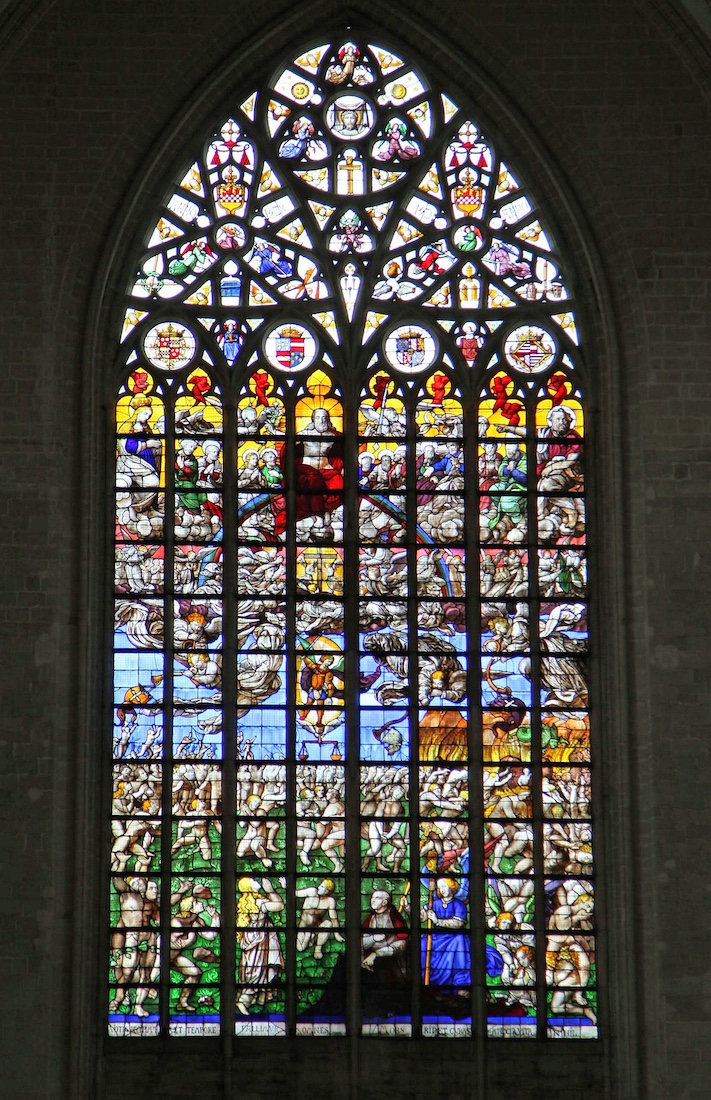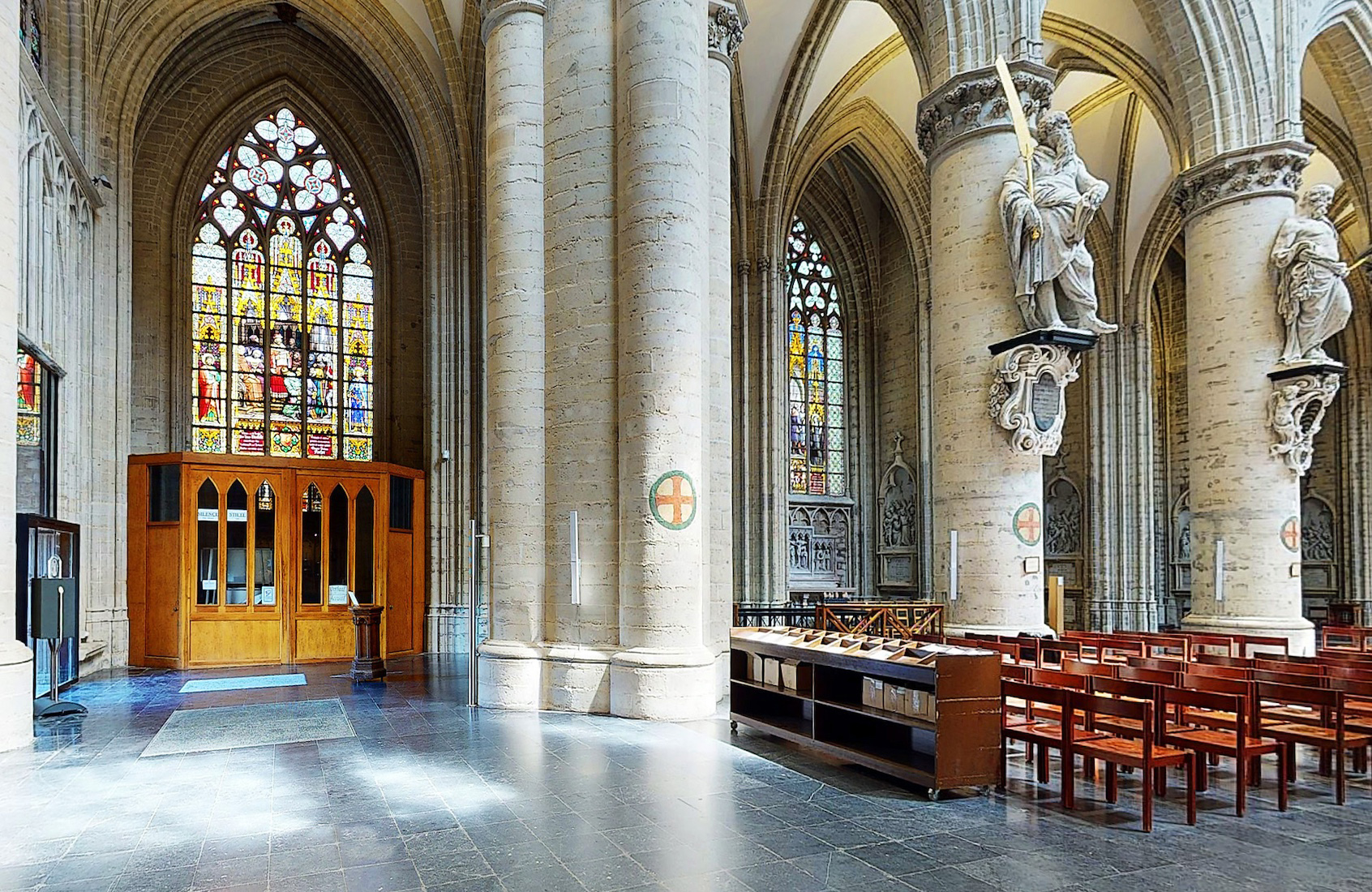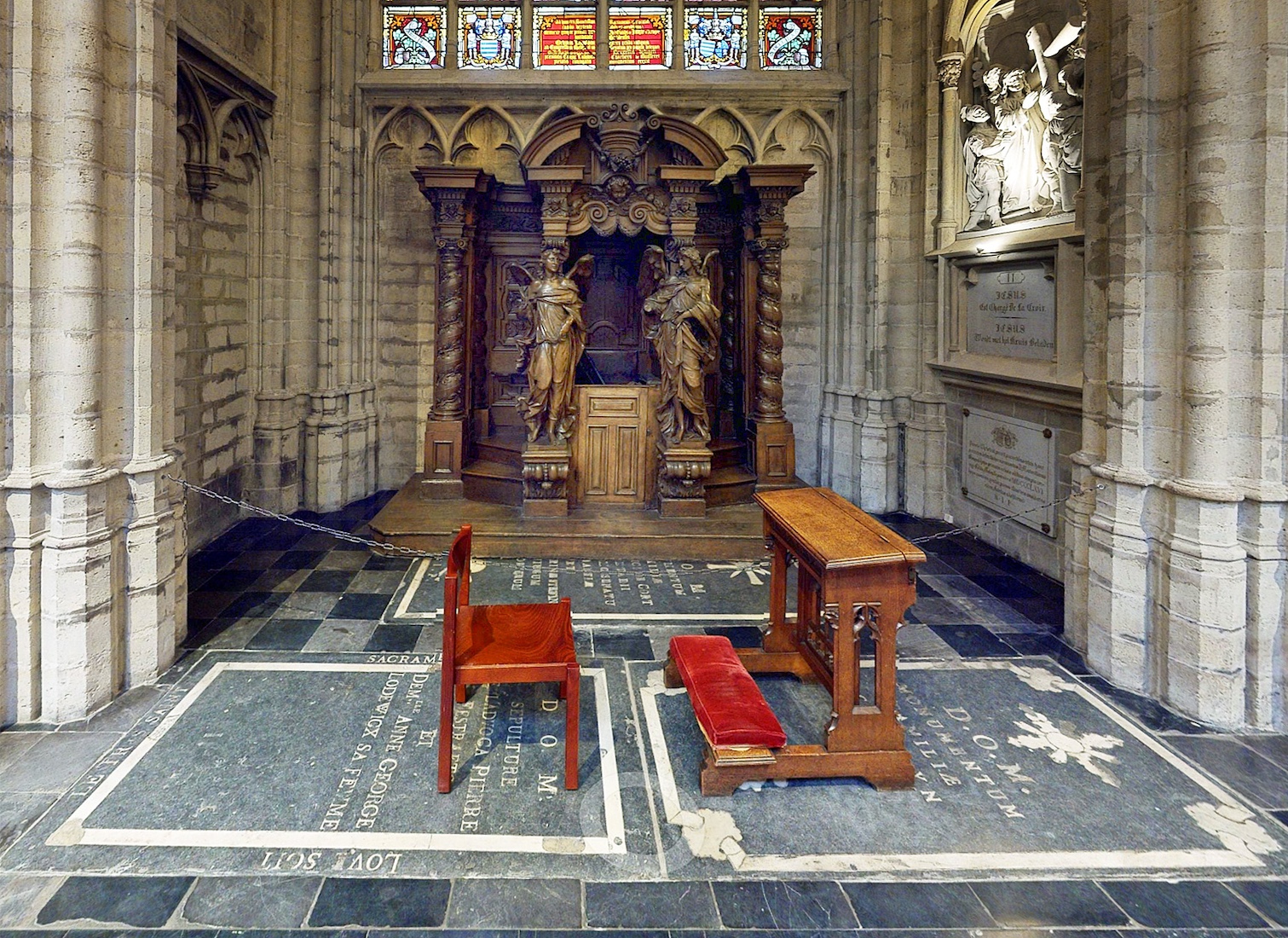
We are going to look at the West wall next, but in so doing we catch our first view of the stunning stained glass of this Cathedral. The red crosses on the columns are likely to be ‘consecration’ crosses, relating to the time when the Cathedral was consecrated. The colourful Great West Window is to our right. [Photo Credit: Wikimedia Uwe Brodrecht] INDEX
22. WEST WALL

Looking at the West wall straight on, we see that as well as the central window there is a smaller window on each side. Also of interest, there are no porches or entry foyers on any of the doors: the Cathedral opens out directly to the exterior. This is a feature of the Brabantine Gothic design, although usually there is a single West tower.
23. GREAT WEST WINDOW
This is the oldest window in the Cathedral. It depicts the Last Judgement and was installed in 1528. Some people think it was the work of Frans Floris but others are not so sure. [Photo Credit: Wikimedia Maxifried]
24. WEST SIDE WINDOWS
Two smaller matching windows are placed over the side doors in the West wall. The semicircular tops depict colourful angels making music and below in each window, three saints are shown. [Photo Credit: Wikimedia Harmonia Amanda] [Photo Credit: Wikimedia Harmonia Amanda]
26. FIRST NORTH WINDOW
The windows in this Cathedral are quite spectacular, with many like this depicting some historic scene spread across the panels, and surrounded by elaborate decoration. This is one of the windows depicting the legend of the Blessed Sacrament telling of the desecration of sacramental bread by Jews in 1370. The window appears to show the Jews being brought to justice after the event. The stained glass was made by Jean-Baptiste Capronnier in the 19th century. [Photo Credit: Wikimedia Uwe Brodrecht]
27. NORTH NAVE AISLE, BAYS 2 – 4
Standing back we can view the next three bays of the North aisle, with each bay having a window and a small chapel feature below. At front left there is a black railing: we shall return to this.
28. NORTH AISLE, BAY 2
These stained glass windows in the nave date from the 19th century, and were produced by Jean-Baptiste Capronnier. They were created in 1870 for the celebration of the fifth centenary of the Sacrament of Miracle. This window appears to show the return of the Holy Sacrament. • The marble monument below remembers Count Arthur Cornet de Ways-Ruart (1866 – 1951). The statue by William Geefs, 1872, shows Faith supporting old age and elevating youth. • To the left side is a British Empire memorial for the First World War. [Photo1 Credit: Wikimedia Zairon]
29. NORTH AISLE, BAY 3
The stained glass window here shows another scene from the Legend of the Miracle of the Holy Sacrament. •• Below is a marble panel depicting from left, the Annunciation in which the Angel Gabriel speaks to Mary, the Crucifixion , and Mary’s visit to her cousin Elizabeth. Interestingly, the name Isobel appears here. Originating from Hebrew, Isobel means “God’s promise” or “pledged to God”. It is a variant of the more popular, Anglicized names, Elizabeth or Elisabeth. •• Standing to the left of the central shrine is a baroque wooden statue of Virgin Mary with the child Jesus. [Photo1 Credit: Wikimedia Maxifred]
30. NORTH AISLE, BAY 4
In the fourth bay along the North aisle, the windows shows a celebratory procession following the recovery of the stolen Sacrament. •• Below the plaque is a memorial to Jean le Duc de Brabant (1267 – 1294) who died in the Battle of Woeringen. [Photo1 Credit: Wikimedia Zairon]
31. STATIONS OF THE CROSS
On the Eastern wall of each of these side chapels, on both the North and South walls, we find one of the 14 Stations of the Cross. You can find the complete set here.
32. WEST CRYPT
We return to the black railing we noticed earlier near the West end of the Cathedral. This encloses a set of steps which lead down to the crypt. This part of the crypt is not elaborate, but on display is a set of early Roman foundations. Later, we shall find another part of the crypt towards the Eastern end of the Cathedral.
33. NORTH NAVE AISLE, BAYS 5 – 7
We return to the nave to investigate the remaining three bays along the North side.
34. NORTH AISLE, BAY 5
This window shows another – unexplained – scene from the Legend of the Stolen Sacrament. •• Below the window is an early confessional – the first of four such confessionals in the nave. Two angels guard the entry to the seat occupied by the priest, but there appears to be no consideration given to the privacy of the priest, nor to the one confessing. The floor is lined with several memorial slabs, including one remembering the de Tourneville family. [Photo Credit: Wikimedia Harmonia Amanda]
35. NORTH AISLE, BAY 6
This window in Bay 6 shows another scene from the Lost Sacrament legend. •• Below the window is another open confessional with two presiding angels. [Photo1 Credit: Wikimedia Maxifred]
36. NORTH AISLE, BAY 7
Here in the seventh window the Lost Sacrament appears to have returned to its rightful place. •• Below we find the third open confessional, and again the floor is lined with memorial slabs. We are reminded again of the Stations of the Cross on the right walls. [Photo1 Credit: Wikimedia Charles Verschaeren]
37. NORTH NAVE AISLE, BAPTISTRY
Our final port of call along the North nave is the much larger baptistry, located right next to the North transept. The windows here are of plain lattice work glass, and one is just a half window – presumably to give greater wall support here. There is an access door to the space to our right. The golden font is round with a very solid canopy – surely with some history! Baptism is the recognised rite of entry into the Christian Church, and indeed into life with Christ.
38. SOUTH NAVE AISLE, BAYS 8 – 6
We cross to the South side of the nave and investigate the windows and side chapels, beginning at the Eastern end. This window is the first in the series of nave windows depicting the Legend of the Stolen Sacrament. The story continues towards the West, and then back along the North nave wall to the North transept.
39. SOUTH AISLE, BAY 8
The Eastern end window depicts another scene from the legend of the Stolen Sacrament: the actual theft of the Host. An unknown King and Queen feature at centre. •• The monument below remembers the Belgian priest Peter Joseph Triest (1760–1836), an inspired man who completely devoted his life to the care of the poor and the sick. He followed in the footsteps of his example, Saint Vincent de Paul. To serve with respect and love became the adage of his life. •• Again there are memorial slabs on the floor. [Photo Credit: Wikimedia Maxifried]
40. SOUTH AISLE, BAY 7
The window in Bay 7 perhaps shows a scene with the Jewish conspirators? •• Below the window is yet another open confessional with angels keeping watch. These are the original oak confessionals from the 17th century. [Photo1 Credit: Harmonia Amanda]
































